ISSN 2348-1218 (print)
International Journal of Interdisciplinary Research and Innovations ISSN 2348-1226 (online) Vol. 9, Issue 3, pp: (17-25), Month: July - September 2021, Available at: www.researchpublish.com

ISSN 2348-1218 (print)
International Journal of Interdisciplinary Research and Innovations ISSN 2348-1226 (online) Vol. 9, Issue 3, pp: (17-25), Month: July - September 2021, Available at: www.researchpublish.com
Department of Chemistry, Appa Institute of Engineering and Technology, Vidya Nagar, Kalaburagi, Karanataka-585 103, India,
E-mail:ambika22bhusange@gmail.com
Abstract: A few copper complexes with N,N'-(6-methyl-1,3,5-triazine-2,4-diyl)bis(3-oxobutanamide) (L1) and N,N'(6-phenyl-1,3,5-triazine-2,4-diyl)bis(3-oxobutanamide) (L2) have been reported in this paper. The electronic, IR, 1H NMR, Powder X ray diffraction, ESR spectral data indicate that Cu(II) complexes show coordination number six with ligands (L1) and (L2) with involvement of one water molecule coordinated to Cu(II) metal ion and this was confirmed by means of the analysed Cu(II) complexes which were studied spectrally and thermally. For the spectrophotometric analysis of Cu(II), a novel form of compound called copper(II) complexes containing L1 as well as L2 has been produced at different temperatures i.e, 250C, 300C, 350C, 400C, 450C, and 500C,. The stability constants values were found to decline with increasing temperature. Gibb's free energy change (ΔG), change in entropy (ΔS), and change in enthalpy (ΔH) are thermodynamic variables were studied. It has been found that the formations of metal complexes are random and exothermic in nature.
Keywords: Entropy, Exothermic, Complexes, Free energy, Spectra.
Heterocycles are the ring compounds that contain one or more diverse ring atoms (i.e. atom other than carbon like N, O, S, P, B, Si, As and Se). Five and six-membered compounds are the most important heterocyclic systems. These are main class compounds which include more than 50% of all well-known organic compounds. They can be drugs, vitamins and natural products[1]. In the ancient times, synthesis of heterocyclic compounds was important because of its broad application. Heterocyclic compounds obtained from nature are important to life[2]. In life science industry and industrial field‟s related to fine and special chemistry, heterocyclic compounds showed important role[3]. They consist of a class of natural and synthetic products; some of them showed good pharmacological property[4]. Triazines have a unique position in pharmaceutical chemistry. It is worked as protecting groups in natural chemistry. Triazines are reactive groups and flexible for different synthetic transformations[5]. Triazine is a six-membered heterocyclic compound with empirical formula C3H3N3. Its structure is analogous to the benzene ring in which three carbons of the ring are substituted by nitrogen atoms. 1,3,5-triazine isomer also called as s-triazine due to the symmetry of three nitrogen in the ring. This isomer is an oldest known organic compound. 1, 3, 5- Triazine represent a broadly used lead structure with remarkable applications in various fields[6] s-Triazines derivatives are an important class of compounds showing many pharmacological activities (like antimicrobial activities). Due to various applications in different fields, 1, 3, 5-triazines constitute a well-known class of composites from an extended time and still continue of considerable interest[7]. Under
ISSN 2348-1218 (print)
International Journal of Interdisciplinary Research and Innovations ISSN 2348-1226 (online) Vol. 9, Issue 3, pp: (17-25), Month: July - September 2021, Available at: www.researchpublish.com
microwave irradiation when primary alcohols or aldehydes reacted to produce transitional nitriles using iodine with aqueous ammonia solution interact with cyandiamide and N3Na to form corresponding s-triazines with good yield[8] Responding active carboxy moieties (acid chlorides, anhydrides, acylimidazolides) using zinc dimethyl imidodicarbonimidates yielded 6-substituted 2,4-dimethoxy-1,3,5-triazines. The activation of the carboxy group was converted at a slow rate in this procedure, yielding modest yields. Whenever a relatively significant surplus of the carboxylic acid counterpart was applied did satisfactory quantities result. Acid chloride interacted using zinc salt that created the equivalent triazine with a medium 53 percent productivity using same trial parameters Whenever acid chloride mixed with salt had been concentrated using 4A0 molecular filters with pyridine as a co-solvent[9], larger quantities were obtained. Considering different experimentation settings, an concise summary including its interactions with 2,4,6- tris(2pyridyl)-1,3,5-triazine (tptz) and in vicinity of rhodium(III), ruthenium(II), as well as osmium(II). Tptz displays metal-assisted hydrolysis/hydroxylation just at triazine ring within particular experimental circumstances. Nevertheless, artificial techniques for creating compounds containing unaltered tptz have indeed been devised. Individual crystalline X-ray studies[10] are used to determine the molecular structures of certain complexes, particularly stereo isomers with hydroxylated products. While treating 1, 3, 5-S-triazine-2, 4, 6-tricarboxylate using ferric ions through water a 1 - d chain [Fe (1, 3, 5-triazine -2, 4, 6-tricarboxylate)[H2O]n having hepta coordinate Fe(II) core being generated and investigated for its magnetic properties[11]. On the basis of literature survey, author has synthesized, characterized and microbial activity study of Cu(II) metal complexes with N,N'-(6-methyl-1,3,5-triazine-2,4-diyl)bis(3-oxobutanamide)(L1) and N,N'-(6-phenyl-1,3,5-triazine-2,4-diyl)bis(3-oxobutanamide) (L2) was carried out
Fig.1: L1: R= CH3, N, N'-(6-methyl-1, 3, 5-triazine-2, 4-diyl)bis(3-oxobutanamide) and L2: R= C6H5, N,N'-(6phenyl-1,3,5-triazine-2,4-diyl) bis (3-oxobutanamide).
All of the reagents utilized during this study were chemically pure grade obtained using S.D.Fine chemicals. They include copper chloride, copper(II) sulfate pentahydrate, sodium hydroxide (NaOH), sodium nitrite (NaNO2), hydrochloric acid (HCl), acetic acid (CH3COOH), sodium chloride (NaCl), ethylacetoacetate, ethylbenzoylacetate, dicyanodiamide, benzaldehyde, salicylaldehyde phenyl hydrazine, ethanol, 2-hydroxyaniline and diethyl ether; purchased from S.D.Fine chemicals. The water utilized was distilled water, and the distillation being accomplished through condensation. Using electronic conductivity, model 19000-05(USA), molar conductivity were evaluated around ambient temperature (25oC).Using a Jasco FT-IR 300 E Fourier transform infrared spectrophotometer, the IR spectra (4000-400 cm-1) being acquired utilizing KBr pellets. Joel JNM-EX 270 FT and Joel 500 AS NMR spectrophotometers are being applied to capture 1H NMR spectra. A Shimadzu UV-240 UV-visible monitoring spectrophotometer has been used to record the electronic absorption spectra. A DTA-7 as well as TGA-7 Perkin Elmer 7 series thermal analysis system was used to perform thermo-gravimetric examinations. Considering Hg[Co(SCN)4] as a calibrant, the magnetic susceptibilities being evaluated utilizing the Gouy technique.
Preparation of 2, 4-diamino - 6-substituted-[1,3,5]-triazine:
A serious primary alcohols and aldehydes were blended in with iodine in ammonia salt water under microwave illumination to give the transitional nitriles, which without detachment went through [2 + 3] cycloadditions with dicyandiamide to bear the cost of the relating triazines in exceptional returns [12].
ISSN 2348-1218 (print)
International Journal of Interdisciplinary Research and Innovations ISSN 2348-1226 (online) Vol. 9, Issue 3, pp: (17-25), Month: July - September 2021, Available at: www.researchpublish.com
Preparation for N , N ' - ( 6 - methyl -1,3,5 -triazine - 2,4-diyl )bis (3-oxobutanamide) and N, N ' - ( 6- phenyl- 1,3,5 – triazine- 2,4- diyl )bis ( 3 –oxobutanamide) (3-oxobutanamide):
Ligands N , N ' - ( 6 - substituted - 1,3,5 - triazine - 2,4 - diyl ) bis (3 –oxobutanamide) were set up by treating 2,4diamino-6-substituted [1,3,5]-triazine (0.01 molar) with ethyl aceto acetate (0.02molar) for 4 min by microwave light, the subsequent product was solidified from hot ethanol, (92%), m.p. 128 °C. Completion of the reaction was checked with TLC [13].
Irradiated production of copper complexes with ligands [L1] with [L2]
A hot solution of copper chloride ( 0.001molar ) into ethyl alcohol be put into a warm solution consisting [L1]/ [L2] ( 0.001molar ) in ethyl alcohol, the response blend be heated in microwave irradiation in favorof 3 - 4 minutes, by then the shade of the mixture was turned, which be reacted by means of sodium acetic acid derivation (0.5 g) the resulting response blend be later heated in microwave lighting up for 2 extra minutes, plus from that point it was broken down via adding to refined H2O ( 80 -100 ml ) through mixing. A segregated strong (complex) was permitted to reconcile as well as amassed by passing through a filter, cleaned a few instants with refined H2O as well as sometime later with boiling ethyl alcohol. A strongcompound obtained be dehydrated inside desiccators above anhydrous calcium chloride.
The fundamental examination Table-1 shows that with the general formula [M(L)]H2O, all complexes are having 1:1 stoichiometry The copper (II) complexes in this study have an attractive instant of 1.85-1.89 Bohr Magneton agreeable to spin only value. It is reported that the distorted octahedral geometry of copper (II) complex have spin interaction exhibit magnetic attraction around nearby vicinity between 1.80-1.93 Bohr Magneton[14-16] In this current examination, three groups were noticed next to 14720.75 cm-1, 18125.20 cm-1 and 32475.65 cm-1for Cu(L1)H2O and 14650.63 cm-1 , 18195.75 cm-1 and 32262.15 cm-1 for Cu(L2)H2O that could be used for conversions 2B1g → 2A1g, 2B1g → 2B2g and 2B1g → 2Eg in that order. These findings suggest that Cu(II) complexes are likely to have a six-coordinated octahedral structure. Cu(II) is a d9 ion that illustrates the John Teller effect well.
Table
Ligands/ Complexes Yield (%) Elamental analysis Cu C H N L1 C12H15N5O4
66 - 63.89 (63.95) 7.42 (7.37) 28.55 (28.63) L2 C18H20N5O4
64(70.61) (6.53) (22.86) Cu(L1)H2O Cu(C12H15N5O4)H2O 82 20.61 (20.65) 50.80 (50.74) 5.80 (5.85) 22.79 (22.75)
Cu( L2) H2O Cu(C18H20N5O4)H2O 78 17.22 (17.19) 58.52 (58.47) 5.38 (5.40) 19.00 (18.93)
The values in the parentheses were calculated one. A typical IR spectrum of Cu(II) complexes with ligands L1 and L2 can be seen. A broad bands observed around 3500 cm -1 due to υH2O vibrations. When it comes to intricates, ligand L1 along with ligand L2 a moderate frequency sharp band around 1613 cm-1 allocated for υC=N has seen a downward move measuring 23-21 cm-1 in all complexes has existed within range 1592-1595 cm-1. The above change in bands towards the lower frequency side in all structures as related with their ligands indicates that the azomethine function's nitrogen atom is co-ordinated in coupling mostly with Cu(II) atoms. The υM-O along with υM-N vibrations[17-18], were allocated to a bands detected with in area 560-530 cm-1 as well as 440-410 cm -1 due to involvement of copper metal in the coordination through oxygen and nitrogen of the ligands L1 also L2 . 1HNMR spectrum of the ligands L1 and L2 displayed a peak observed at 9.55 ppm in case of ligands is assigned to the protons of the NH groups. Three protons of methyl group are resonated as singlet at 2.31 ppm (s, 6H, 2CH3). Four protons of phenyl ring are appeared as singlet at 7.42-7.56 ppm (s, 4H, Ar-H) and four protons of (4H, s, 2COCH2-CO),are appeared as singlet at 3.46 ppm. At room temperature, electron paramagnetic resonance spectroscopy for copper
ISSN 2348-1218 (print)
International Journal of Interdisciplinary Research and Innovations ISSN 2348-1226 (online) Vol. 9, Issue 3, pp: (17-25), Month: July - September 2021, Available at: www.researchpublish.com
complex [Cu(L1)]H2O was studied. The g value somewhere around g=2.3 with considering ionisation property, the ionic nature including its M-L interaction is higher above 2.3 has been stated by Kivelson as well as Neiman[19]. The [Cu(L1)]H2O complex in this study has a g value of 2.46, suggesting that only the metal-ligand bonds are more ionic in nature. In order to learn more about the copper's composition in the structure of copper (II) complex, ESR studies of the complex have been made. The magnetic parameters have been evaluated from the spectra and tend gII > g┴ due to the occurrence of such electron that has not been coupled into dx2-y2 field is suggested by observed „g' values[20-21] Based on these observations copper (II) complex may have octahedral geometry. In case of diffraction of powdered X-rays in support of Cu(C18H20N5O4)H2O, It is seen that the complexes consists of some reflections between 10 – 68o (2ɵ) resulting first from diffraction of x-rays via metal ion planes Using Bragg's relationship, nλ = 2d Sinɵ, where the X-radiation frequency applied (Copper kλ = 1.54056 A0), an inter planar spacing (d) was determined from the places of extreme point. The measured spacing as well as corresponding peak including most extreme peaks are reported. Many of the major peaks have an index[22-23], and their Sin2 ɵ values are compared to those measured. When these values are correlated, it is obvious that the measured and observed values are in excellent accordance. Such complex illustrate broad peak representing amorphous nature of the complexes.
Thermogravimetric analysis as well as differential thermal analysis was used to evaluate the aggregates' thermophysical properties in a nitrogen atmosphere at temperatures ranging from 37 to 750 oC. Fig.2. demonstrates the Thermogravimetric analysis and Differential thermal analysis curves of the Cu(II) complex. The thermal performance of the Cu(C12H15N5O4)H2O complex of ligand L1 revealed that the complex is strong nearer 97 degrees Celsius and that there seems to be zero decrease in weight unless given temperature is reached. An initial step in the intricate breakdown process lasts up to 97°C, contributing the loss through one water atom. The second phase for decay takes place at 278 degrees Celsius, leading to the loss of both C5H6NO2 groups. Following that, the compound deteriorated steadily up to 750°C, with the remaining organic moiety losing mass. Metal oxide is the final mass of a product[24]
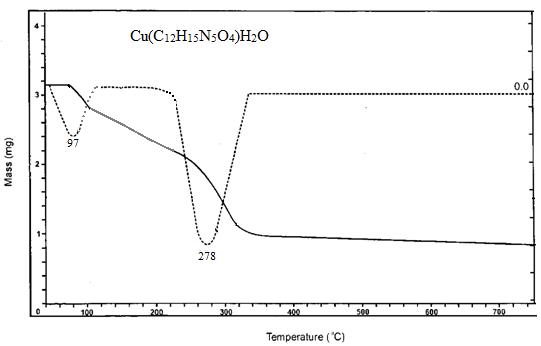
On the basis of analytical data, electronic spectra, magnetic susceptibility measurements, IR, NMR, ESR Powder x-ray diffraction study and spectral data, octahedral geometry has been assigned to copper (II) complexes.
Evaluation of stability constants of Cu(II) complexes of ligands L1and L2 by spectrophotometric method:
At pH 7.8 ± 0.05 buffer solutions, the reaction of ligands L1 as well as L2 through copper(II) sulphate pentahydrate be studied at three temperatures: 25, 30, 35, 40 45, also 50 °C. Certain absorption spectra are recorded over some wavelength at 535 nm. It was found that ligands L1 and L2 with copper (II) sulfate pentahydrate produced a brown colored, water soluble complex. Pure Ligands L1 also L2 do not diffuse considerably across the wavelength spectrum studied under same circumstances. CuSO4(II) with five water molecule deliberation influences primarily on complexation for ligands L1 with L2 revealed for optimum complex formation[25-26], a mole proportion of one of solvents to analyte is needed. The
ISSN 2348-1218 (print)
International Journal of Interdisciplinary Research and Innovations ISSN 2348-1226 (online)
Vol. 9, Issue 3, pp: (17-25), Month: July - September 2021, Available at: www.researchpublish.com
structure as well as stabilization parameters of both the compounds are determined using Job's continuous variation approach as well as the mole ratio process[27]. at various temperatures 25, 30, 35, 40, 45, and 50 °C.
A aliquot of 60x10-4 to 0 M ligands L1 and L2 was pippetted into seven volumetric flasks of copper(II) sulphate pentahydrate standard solution 0 to 60x10-4 M. Over various temperature conditions such as 25, 30, 35, 40, 45, as well as 50 degrees Celsius, all measurements were taken at 535 nm . The curve peaks at a mole fraction of metal = 0.5, indicating the creation of a complex having an 1:1 M:L proportion[28-29] (Fig.3). Following is the equation for Job's system that was used in this study:
As, A1 = absorbence near its threshold, A2 = real absorbence, CM = concentration of copper-metal, as well as CL= quantity proportion of ligands Using the mole ratio method[30], With a stoichiometric ratio of 1:1, a distinct pattern has been detected. L1 and L2 and Cu(II) (Figure 3 and 4) at 535 nm and these three temperatures at constant Cu(II) concentration (1510-4M) and varying L1 and L2 concentrations (0 to 3510-4M), at 535 nm and these three temperatures
Fig.3: Representative Jobs curves of Cu(II) complexes with L1at 250C, 30 0 C , 40 0C and 45oC
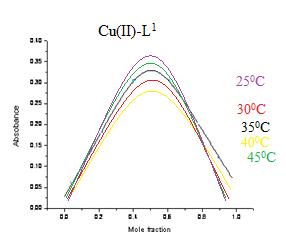
In mole ratio method keeping the copper concentration constant, the concentration of the reagent is varied[31-32]. For each experimental solution the absorbance value is measured at 535nm against reagent blank. Mole ratio method also confirms that the ratio between the metal ion and the reagent is 1:1 (M:L). A graph is plotted between L1 and L2 ligands volume and the absorbance (Fig.4).
The preceding is the relevant equation for the mole ratio method: [ ]
Where A = absorbance at crest tip and εb = molar absorptive stable unit
The stability constants have been calculated using both Job's as well as Mole ratio techniques, based on the information collected, the average data of Kf acquired using two separate methods are in fair agreement (Table 2).
ISSN 2348-1218 (print)
International Journal of Interdisciplinary Research and Innovations ISSN 2348-1226 (online) Vol. 9, Issue 3, pp: (17-25), Month: July - September 2021, Available at: www.researchpublish.com
Fig. 4: Mole ratio curves for copper(II) complexes with L1 at 250C, 300C, 350C, 400C, 450C and 500C.
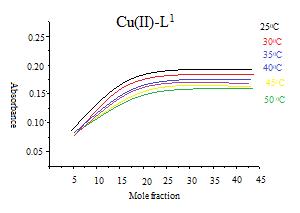
Both the copper complexes with the investigated ligands L1 and L2 thermodynamic parameters ΔG°, ΔH°, and ΔS° were calculated. The relationship between a complex's free energy of formation (ΔG°) and its stability constant by the relation[33-34] is: –ΔG ° = 2.303 RT logβ, while R = universal gas constant, T = absolute temperature, as well as log β = complex constant parameter. Through the graph, logβ versus 1/T, both the enthalpies of formation (ΔH°) as well as entropy (ΔS°) have been determined. The following relationship can be used to determine the statistical reliability including its constant factor on temperature:
∆G° = ∆H° – T∆S°
∆G° = –2.303 RT logβ = ∆H° – T∆S°
By rearranging, we get logβ = –∆H°/(2.303 RT) + ∆S°/(2.303 R)
That seems to be in fact, an mathematical statement with a formula y = mx + b, in which y = logβ, m = –ΔH°/(2.303 R) = slope, x = 1/T, and b = ΔS°/(2.303 R) = obstruct. The latter indicates that a graph with logβ against 1/T with Slope = ΔH°/(2.303R) with obstruct = ΔS°/(2.303R) would be normal unless the K values for such a specific interaction were calculated over different temperatures. Such finding suggests both ΔH° as well as ΔS° seem to be independent of temperature with consideration of wide range of temperatures. Over a limited temperature range, this statement is a reasonable approximation.
Table 2. Metal-ligand formation constant determined using Job’s continuous variation process and the mole ratio approach at 25oC, 30 oC, 35oC, 40 oC, 45 oC and 50oC and p H of 7.8 ±0.05.
Methods Complexes
M:L 1:1
Job‟s Method
Formation Constants at temperatures 25oC 30 oC 35 oC 40 oC 45oC 50oC
Cu(II)-L1 Kf 8.35x104 7.45x104 6.38x104 5.62x104 4.25x104 3.44x104
Logβ 4.92 4.87 4.80 4.75 4.63 4.54
Cu(II)-L2 Kf 12.38x104 11.35x104 10.65x104 9.25x104 8.12x104 7.52x104
Logβ 5.09 5.055 5.027 4.97 4.90 4.88
ISSN 2348-1218 (print)
International Journal of Interdisciplinary Research and Innovations ISSN 2348-1226 (online) Vol. 9, Issue 3, pp: (17-25), Month: July - September 2021, Available at: www.researchpublish.com
Cu(II)-L1 Kf 7.25x104 6.22x104 5.85x104 4.15x104 3.72x104 2.84x104
Mole ratio method
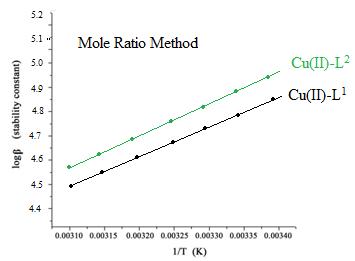
Logβ 4.86 4.79 4.76 4.62 4.57 4.45
Cu(II)-L2 Kf 8.56x104 7.45x104 6.75x104 5.33x104 4.25x104 3.64x104
Logβ 4.93 4.87 4.82 4.72 4.62 4.56
Fig.5: Plots of logβ versus 1/T for L1 and L2 with investigated Cu(II) complexes by Jobs Method.
Fig.6: Plots of logβ versus 1/T for L1 and L2 with investigated Cu(II) complexes by Mole ratio Method. The values of the thermodynamic parameters ΔG, ΔH, also ΔS were determined34 using the log β quantities as well as the heat effects. The values of stability constants in Table 3. reveals that the stability constants decline as the temperature goes up.
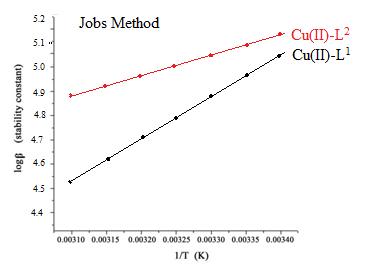
ISSN 2348-1218 (print)
International Journal of Interdisciplinary Research and Innovations ISSN 2348-1226 (online) Vol. 9, Issue 3, pp: (17-25), Month: July - September 2021, Available at: www.researchpublish.com
Table 3: Thermal behaviour components(△H°, △G° with △S°) used for Cu(II) complexes with both the analyzed ligands (L1-L2).
Methods Complexes△G°(kJ/mol)△H°(kJ/mol) +△S°(kJ/mol.K)
Jobs Method
Mole ratio Method
Cu(II)-L1 36.23 34.25 0.007 Cu(II)-L2 42.55 38.43 0.018
Cu(II)-L1 57.57
33.24 0.042
43.28 0.043 Cu(II)-L2 44.35
A few complexes with N,N'-(6-methyl-1,3,5-triazine-2,4-diyl)bis(3-oxobutanamide) (L1) and N,N'-(6-phenyl-1,3,5triazine-2,4-diyl)bis(3-oxobutanamide) (L2)with copper metal ions have been reported in this paper. These complexes analyze for the stoichiometry along with a kind (1:1) [M:(L)]H2O. An spectral data indicates that pentadentate activity is shown by ligands L1 and L2, coordination takes place from the ligands L1 and L2 through oxygen and nitrogen. The non electrolytic nature of these complexes is shown by the conductivity details. Certain magnetic susceptibility measurements obtained for Cu(II) complexes at room temperature correlate with spin only values. The electronic, IR, 1H NMR, Powder X ray diffraction, ESR spectral data indicate that Cu(II) complexes show coordination number six with N,N'-(6-methyl1,3,5-triazine-2,4-diyl)bis(3-oxobutanamide) (L1) and N,N'-(6-phenyl-1,3,5-triazine-2,4-diyl)bis(3-oxobutanamide) (L2)
with involvement of one water molecule coordinated to Cu(II) metal ion, this was confirmed by the spectral and thermal studies of the investigated Cu(II) complexes. Spectrophotometrically measured data for copper(II) complexes with L1 with L2 was created at different temperatures i.e, 250C, 300C, 350C, 400C, 450C, and 500C,. Properties with stability constants were discovered to decline with increasing temperature. Change in Gibb's free energy (ΔG), change in entropy (ΔS), with change in enthalpy (ΔH) have been recognized as thermodynamic parameters for complexation reactions. It has been found that the formations of metal complexes are random and exothermic in nature.
The authors are thankful to Poojya Dr.Sharanbasvappa Appa, President Sharanbasveshwar Vidya vardhak Sangha, Kalaburagi, Dr. Anilkumar Bidve, Dean, Principal Dr. Basavaraj Mathapathi, Appa Institute of Engineering and Technology, Kalaburagi, Karnataka, for their constant encouragement and support during the process of performing this work.
[1] Morrison R T, Boyd R N, Organic Chemistry. Chapter 27, third edition, Paula Yurkanis Bruice, University of California, Santa Barbara, Fifth impression, p. 1133(2009).
[2] Khalil A E G M, Berghot M A, Gouda M A, Journal of the Serbian Chemical Society,76, 329-39, (2011)
[3] Patel R B, Chikhalia K H, Journal of the Brazilian Chemical Society, 18, 312-21,(2007)
[4] Elgazwy A S H, Zaky H T, Arkivoc, 10, 162-72(2006)
[5] Dawane B S, Kadam S N, Shaikh B M, Der Pharmacia Lettre, 2, 126- 31(2010)
[6] Vora J J, Vasava S B, E-Journal of Chemistry, 6, 201-6,(2009).
[7] Afonso CAM, Lourenco NMT, Molecules, 11, 81-102, (2006).
[8] Shie J J, Fang J M Journal of Organic Chemistry, 72, 3141-4(2007)
ISSN 2348-1218 (print)
International Journal of Interdisciplinary Research and Innovations ISSN 2348-1226 (online) Vol. 9, Issue 3, pp: (17-25), Month: July - September 2021, Available at: www.researchpublish.com
[9] Oudir S, Rigo B A, Synthesis, 17, 2845-8,(2006)
[10] Parimal Paul, Proc. Indian Acad. Sci. (Chem. Sci.), 114, 4, 269–276, (2002)
[11] Jose Ramin, Golan Mascaros, Juan Modesto, Clemento Juan and Kim R. Dunbar, J. chem. Soc. Dalton trans 27102713,(2002).
[12] J.-J. Shie, J.-M. Fang, J. Org. Chem.,72, 3141-3144,(2007).
[13] Pradip P. Deohate and Roshani S. Mulani, Asian Journal of Chemistry,31,(5),1087-1090, (2019).
[14] M Kato, H B Jonassen and J C Fanning. Chem. Rev., 64, 99, (1964)
[15] T. Dziembowska, N. Guskos, J. Typek R. Szymezak, Likodimas, S. Glenis, C. L. Lin, M. Wabia, E. Jagodzinska and Fabrycy, Materials Research Bulletin., 34, 943(1999)
[16] S. K. Mandal, L. R. Thomson K. Nag, J. P. Charland and E. Gabe, J. Can. J. Chem., 65 2815(1987).
[17] Z. H. Chonan and Rauf, Synth. React. Inorg. Met-org. Chem., 26(4), 591(1996).
[18] B. Bipin Mahapatra and S. K.Saraf, J. Indian Chem. Soc., 80, 696(2003)
[19] O.Kivelson and R.Neiman, J.Chem. Physc., 35, 149 (1961)
[20] B.A. Goodmm and J.B. Rayner, “Advanced in Inorganic Chemistry and Radio Chemistry” Ed.By H.T. Emelous and A.G. Sharpe 13, 135 (1970)
[21] Singh and V. Srivastava Synth. Reent, Inorg. Met. Org. Chem. 18(5), 515-518 (1988).
[22] B D Cullity “Elements of X-ray diffraction”, Wesley publishing company, Inc., England(1959).
[23] B. F. levine, Phy. Rev., B, 87, 2591 (1975).
[24] M. Shebl, J. Coord. Chem., 69,19,(2016).
[25] Snell, F.D., Photometric and Flourometric Methods of Analysis (metals), Wiley Inter science Pub., Parti, Chapters, P. 141-273, (1978).
[26] J. W. Turczan, Analytica.Acta., 36, 13(1977)
[27] V. G. Fazakerley and Walter gordy, J. Chem. Phys., 19, 1181(1957)
[28] L.Sacconi and M.Ciampolini, J. Chem.Soc , 276, (1964)
[29] D. W. Meek and S.A. Ehrhardt, Inorg Chem., 4, 584, (1965)
[30] Snathorst D, Dresburg H. M., Perenboom J.A A J & Keijzers C.P, Inorg. Chem., 20, 2526,(1981)
[31] Billig E, Williams R W, Bernal I and Gray H.B. Inorg. Chem., 3, 663,(1964).
[32] C. C. Agatha, C. Shiju and T. F. Abbs fen reji, EJPMR, 3, 238, (2016)
[33] Zumdal, S.S. Chemistry. 4th Edition, Houghton Mifflin Company,(1997)
[34] Yadav, S.S. and Saxena, R.S. Journal of the Indian Chemical Society, 86(2), 168-170,(2009)